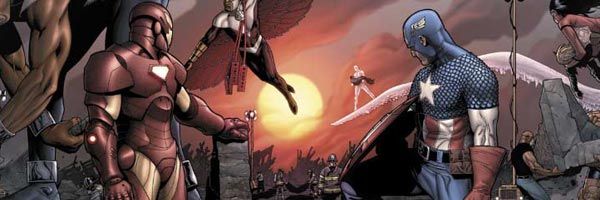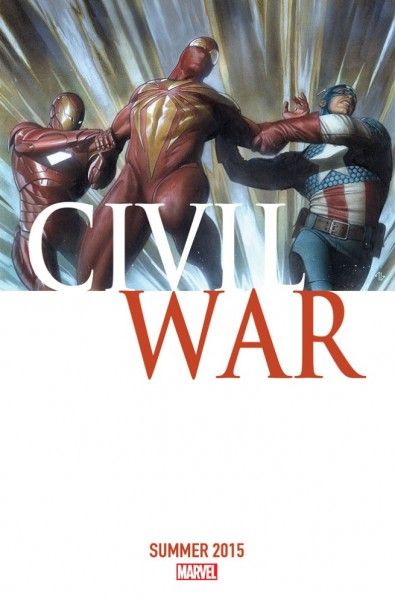Quite the bit of news has been revealed the past week. Not only is Robert Downey Jr. in talks to co-star in the third installment of the Captain America franchise, but this may very well usher in one of the biggest storylines in Marvel history, Civil War. Don’t know what Civil War is and why it’s causing such a fuss? Collider has your back as we thought it would be a great opportunity to walk you through the origins of the event, its players, its ending, and how it could possibly be orchestrated in the current Marvel movie landscape. Hit the jump for our in-depth look at the Marvel storyline, Civil War.
The Lines Are Drawn
Civil War began in 2006 and was created by writer Mark Millar (who also created Kick-Ass) and artist Steve McNiven. The story begins with a group of young, inexperienced heroes named the New Warriors taping their reality show in the quiet town of Stamford, Connecticut. As part of their usual show, the heroes tackle a group of super villains holed up in a suburban household. During said brawl, one of the villains is tossed into a school bus near an Elementary School. The villain in question is Nitro, the human bomb, who lives up to his name and detonates himself, destroying the school, the children therein, and a good portion of the population of the town. The heroes of the Marvel Universe attempt to clean up, both physically and politically, but the U.S. government had enough. It was time for a change and thus the Superhuman Registration Act was born. What the “Registration Act” boiled down to was, if you were a person with superpowers, you had to be an agent for the government or else you were either imprisoned or your powers were taken away. In becoming a government agent, you would be given training by some of the best and brightest in the hero community and be a part of the “Initiative” which was a nationwide program where each state would have its own superhero team. One would also need to reveal their secret identities to the government as well.
As you can imagine, not everyone was thrilled with the idea of having to be an agent of the U.S.A. and surprisingly enough, the top hero opposed to the measure was Captain America. Believing the Act to be a flagrant abuse of power and taking of individual heroes’ rights, Cap went underground and began amassing an army of like-minded heroes, such as the Punisher, Hercules, and many other “street level” heroes. On the other side of the coin, Tony Stark believed that the Superhuman Registration Act was the natural next step in putting an end to a possible war between heroes and villains, while also holding heroes accountable for any potential damage they may do while hero-ing. Stark was joined by a lot of the heavy hitters of the Marvel Universe, along with the “big brains” of the universe including Reed Richards, aka Mr. Fantastic of The Fantastic Four, and Hank Pym aka Ant-Man. With the battle lines drawn, the two warring hero armies began fighting one another with casualties and heartbreak along the way.
Shots Fired
While Civil War had lasting ramifications for the Marvel Universe as a whole, there was no greater impact felt than on the character of Spider-Man. This of course makes for a tricky situation for the Cinematic Universe in that Spider-Man was such a key focal point for Civil War, and yet is not allowed to be used in the Marvel Studios’ films. Rumors are swirling that Marvel and Sony are in preliminary talks to maybe share the character, but the earliest this deal could materialize onscreen would be 2020 so his appearance in Captain America 3 is out of the question. The Civil War comic storyline saw a Spider-Man who sided with Iron Man, using his “With Great Power comes Great Responsibility” schtick to push himself into working as an agent of the government. The bombshell dropped, of course, when Spider-Man and Stark called a press conference for the express purpose of Spider-Man revealing he was Peter Parker to the world. This, OF COURSE, goes terribly for Peter as all his villains eventually descend upon him, he loses his job, and comes to blows with Stark after realizing that Registration isn’t all it’s cracked up to be. The world later forgot Spider-Man’s identity thanks to a technology spell created by Dr. Strange and Reed Richards because comic books.
While this is happening, Cap and Company are attempting to fight crime while also being hunted by Iron Man’s Pro-Registration goons. The two sides go to war where it is revealed that Iron Man not only cloned Thor to give his group an edge, but also began employing supervillains to track down the unregistered heroes by planting nanomachines in their brains. This was one of the fatal flaws when it came to the story of Civil War in that the Iron Man’s group became very much like super villains, whereas Cap’s side seemed like the heroes of the picture. Ultimately, the story should have tried to present both sides as being “right” and let the audience decide which side they stood on. Eventually, in a final drag out fight in the streets of New York City, Captain America realizes that punching Iron Man really hard wasn’t going to change governmental policy and gave himself up to the authorities. This led right into the “Death of Captain America” storyline wherein Steve Rogers was killed to be replaced as Captain America by Bucky Barnes, aka The Winter Soldier. Steve was eventually brought back since he was actually shot with Time Bullets created by the Red Skull because you know, comic books.
The story created a landscape for the Marvel Universe moving forward that showed two different, yet interesting sides of being a hero. One was living as a celebrity, embracing the Registration Act, getting paid for being a hero, and receiving training before hitting the field. The other was the unregistered side where heroes were living underground, attempting to fight crime while also staying one step ahead of Tony Stark and his team of Avengers. The whole status quo eventually fell apart as Norman Osborn took advantage of the situation, had Stark “dethroned” as head of S.H.I.E.L.D., and the Registration Act eventually repealed once Osborn himself hit the bricks.
Civil War: Coming To A Theater Near You
Obviously, there’s going to be a lot of changes to the story of Civil War to bring it from the comics to the big screen, but Marvel Studios has yet to completely adapt a comics storyline intact so this is par for the course. We have a cinematic universe created where there is no mention of mutants or Spider-Men or in fact secret identities at all, really. Everyone knows who Captain America, Iron Man, and the Hulk actually are, so one would need to take that part of the story out of the equation. Focus would likely need to be placed on the idea of these heroes who are now living in a world without S.H.I.E.L.D. This could somewhat stem from the end of Captain America: The Winter Soldier, wherein government officials questioned Black Widow regarding her acts during the film and history with the Avengers. Their fear of an unregulated force such as this team of “misfits”, along with the potential events of Avengers: Age of Ultron, could easily set the stage for the cinematic universe’s own Civil War storyline.
Civil War is one of the most polarizing “crossover events” you’ll find in mainstream comics in the last decade, though it’s also arguably one of the biggest. It introduces a lot of weighty, real world concepts to the land of super heroics. We’ll see how Marvel Studios takes this idea and runs with it as details begin to emerge about Captain America 3, but I for one would love to see this one be Marvel’s next big event.


